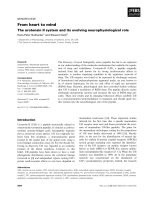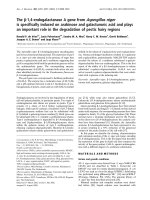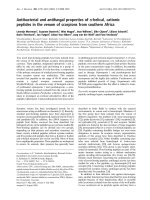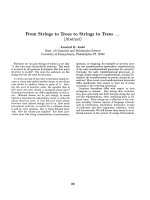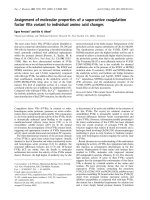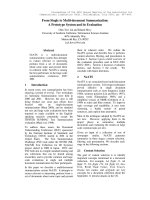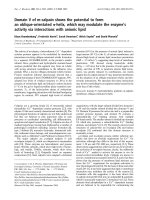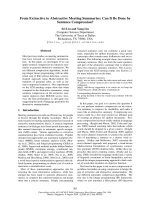Báo cáo y học: "From 2009 to 2019: what a change" pot
Bạn đang xem bản rút gọn của tài liệu. Xem và tải ngay bản đầy đủ của tài liệu tại đây (36.83 KB, 2 trang )
Available online />Page 1 of 2
(page number not for citation purposes)
May 2019 – The New York Times, the International Herald
Tribune and the Frankfurter Allgemeine, based on a large
survey conducted in the US, Canada, Europe, Australia and
China, have concluded that the intensive care unit (ICU) is
the most appealing workplace in the world.
Financial institutions and the stock exchange had been
ranking highest in these regular international surveys until
2008, when they dropped abruptly to the 167th position and
were replaced at the top by the workplaces of information
technicians, software developers and airline pilots. Profes-
sions in health care have been on a steady rise since 2012,
reaching top positions in 2015. Schools of medicine, nursing,
public health and of other health care professions increased
their enrolments by 120% between 2009 and 2015. At the
same time, health care systems underwent dramatic improve-
ments in all regions of the world. Not only have professionals
in this field gained in recognition, but their workplaces –
public hospitals, policlinics and doctors’ offices – now
resemble modern airports or museums of modern art or the
Chancellor’s Office in Berlin.
These days, waiting lists for nurses wanting to work in the
ICU are long and the interest among medical students,
residents and board-certified internists, anaesthetists and
intensivists to get a post in this part of the hospital is great.
Quite a change since 2009, when a significant number of
ICU beds were closed in many places, often for prolonged
periods, due to a chronic lack of personnel. Nonetheless, the
ICUs continued to work smoothly due to the enthusiastic
spirit and dedication of mostly the experienced staff and
attendants, which kept the group active and the ambiance
positive. Finally, was it the shortage of human resources or
the ever-increasing administrative hassle, the economic
pressure to decrease the cost of everything or the increasing
refusal of younger RNs and residents to stay in this ‘crazy
place’, ignoring their dreams and priorities in life, that initiated
the radical changes? Not really.
In the first place, society has changed. Quite possibly it
started in Switzerland, where first, the government was
forced to abolish banking secrecy after too many scandals
and too much financial turmoil and bankruptcy, and second, a
popular vote on 17 May 2009 changed the constitution so
that all Swiss would have guaranteed access to ‘alternative
medicine’ in addition to classical, science-based medicine.
Soon thereafter, a new party was created in Germany –
‘Health now, Mercedes much later’ – and its candidates won
a fifth of the seats in parliament that fall. In its first action, the
new party called for spending at least 25% of the gross
national product on public health, a measure that passed by a
landslide in parliament. Similar movements emerged in Great
Britain, Russia, China and the US. As in Germany and the US,
increases in taxes on tobacco products, soft drinks, gasoline,
large cars, big incomes and airline passengers (1 cent per
kilogram of body weight per 1,000 miles) were introduced to
increase revenue for health care. The positive effects were
astonishing: new clinics could be built, salaries of health care
workers were doubled, patients were happy and more small
cars and airline tickets were sold to physicians and nurses
than ever before.
Society, patients and their families have changed too – really
taking care of their health and caring about quality of life and
demanding that high-tech high-cost medicine be limited to
cases that clearly make sense, not in hopeless situations, not
at 85.
ICUs were the first in the new system to develop the principle
of ‘quality of life above all – for patients and staff’, giving the
team the responsibility of organizing the service according to
principles of sound patient care and quality of professional
life, including flexible shifts, job-sharing and part-time employ-
ment. On the same floor as the ICU, a nursery, which also
serves the families of the cardiology and emergency depart-
ment staffs, makes it possible for young mothers and fathers
to feel close to their children during the day. Many tasks have
Editorial
From 2009 to 2019: what a change!
Peter M Suter
Centre Médical Universitaire, University of Geneva, CH-1211 Genève 4, Switzerland
Corresponding author: Peter M Suter,
Published: 1 June 2009 Critical Care 2009, 13:153 (doi:10.1186/cc7895)
This article is online at />© 2009 BioMed Central Ltd
ICU = intensive care unit.
Critical Care Vol 13 No 3 Suter
Page 2 of 2
(page number not for citation purposes)
changed hands in recent years: administration is run by clerks
and administrators, management of beds and transferrals by
patient-flow managers. Other tasks remain the same: nurses
nurse, monitor and provide care, doctors search for a
diagnosis and apply therapies. Both groups of professionals
are as dedicated to global and human care as their
colleagues were 10 years ago, but with the satisfaction of
having more time to practice that dedication. Even more
importantly, the staff is happy to work in this setting for many
many years because the new values and priorities of their
generation are recognized: not too many hours on the job,
enough time for family, friends and outdoor activities – a hike
or a bike – and no Mercedes and no investments in stock
markets, which were closed definitively last year, in 2018.
Competing interests
The author declares that he has no competing interests.
